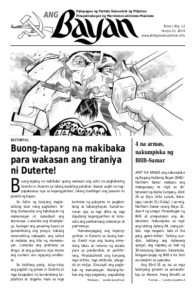Duterte’s land program: Reconcentration, not distribution
Rodrigo Duterte’s so-called land distribution is bogus. Behind this, the Department of Agrarian Reform (DAR) is railroading the reclassification and conversion of agricultural lands to speed up its reconcentration in the hands of big land lords and bourgeois compradors.
From April to May this year, DAR issued one administrative order after another to hasten the reclassification of agricultural lands and convert these for residential, commercial and industrial use. Aside from “simplifying” the process, the DAR also established a special committee to fast track applications for conversion and award exemptions from the Comprehensive Agrarian Reform Program (CARP).
These orders followed Duterte’s executive order to put applications for land reclamation near big cities under presidential authority.. This is to expedite the reclamation process and allow the president to monopolize kickbacks from the construction of commercial establishments and airports on reclaimed lands.
These orders precede the National Land Use Act, one of the Duterte regime’s priority bills, that will reclassify agricultural lands and forests, in compliance with the longstanding demands of real estate developers, big agribusiness companies and other big capitalists. The law will facilitate widespread land grabbing of agricultural lands from peasants and national minorities to give way to the construction of roads, airports, subdivisions, buildings, dams, energy plants and other big infrastructure projects under his Build, Build, Build program. In his haste, Duterte wants to shorten the reclamation application process from 26-36 months to 30 days.
Government data indicate that from 1998 to 2016, around 98,000 hectares of agricultural lands (equivalent to land areas of Metro Manila and Cebu) have been converted to residential, commercial and industrial uses. This figure does not include applications approved by local government units and lands illegaly converted. Majority of these converted lands are in Luzon (80%), especially in CALABARZON (Southern Tagalog) and Central Luzon.




